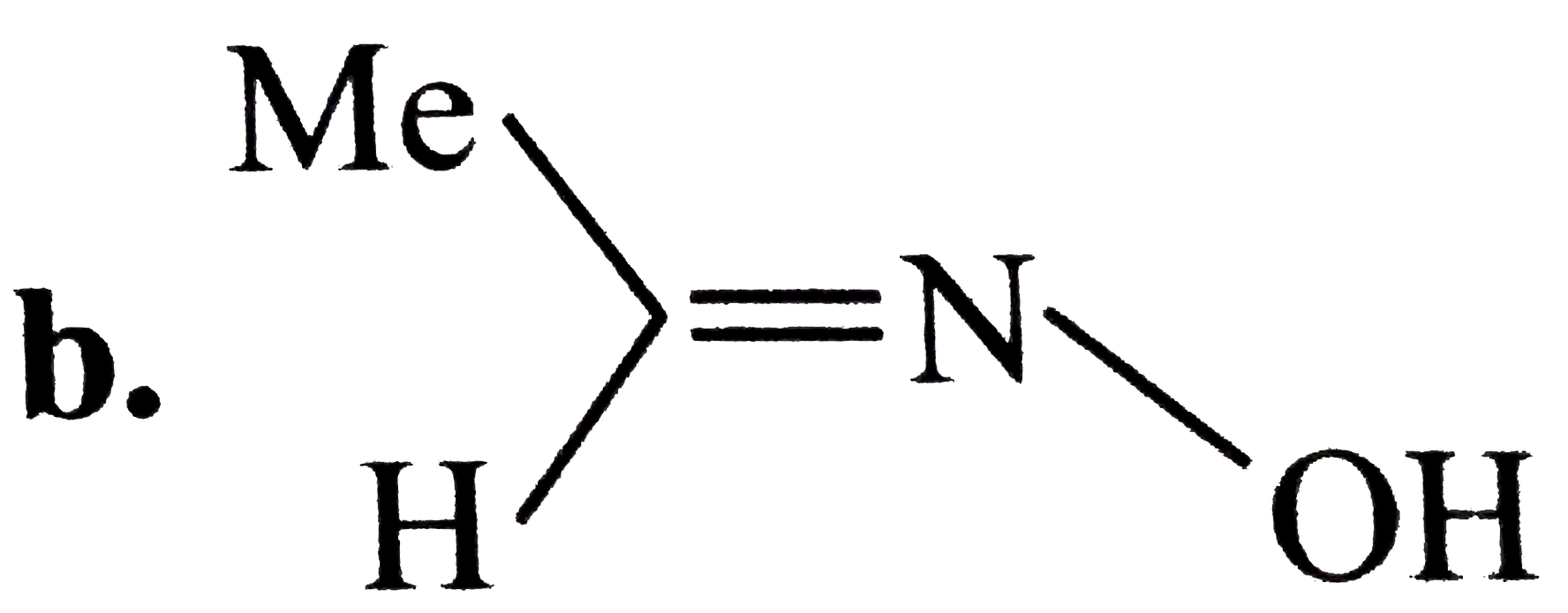Product (C ) is:



The correct Answer is:C
To solve the problem, we need to analyze the reaction between the given aldehyde (MeCH=O, which is acetaldehyde) and hydroxylamine (H2NOH) in the presence of sodium formate (HCOONa) and heat. The product (C) we are looking for is formed through a series of steps involving the formation of an oxime and then a subsequent reaction leading to a nitrile.
1. Identify the Reactants:
- The reactants are acetaldehyde (MeCH=O) and hydroxylamine (H2NOH).
2. Formation of Oxime:
- When acetaldehyde reacts with hydroxylamine, it undergoes nucleophilic addition. The nitrogen atom of hydroxylamine attacks the carbonyl carbon of acetaldehyde.
- This results in the formation of an intermediate where the nitrogen is bonded to the carbon and the hydroxyl group (OH) is attached to the nitrogen, leading to the formation of an oxime.
- The structure of the oxime formed is CH3C(=N-OH)H.
3. Dehydration of Oxime:
- Upon heating, the oxime undergoes dehydration (loss of water). The hydroxyl group (OH) from the oxime and a hydrogen atom from the adjacent carbon are eliminated, forming a double bond between carbon and nitrogen.
- This results in the formation of a nitrile (specifically, ethane nitrile or acetonitrile).
4. Formation of Product (C):
- The final product (C) is ethane nitrile (or acetonitrile), represented as CH3C≡N.
5. Overall Reaction:
- The overall reaction can be summarized as:
MeCH=O+H2NOHHCOONa,Δ−−−−−−−→C (CH3C≡N)+H2O
Final Answer:
The product (C) is Ethane nitrile (CH3C≡N).
---
- The reactants are acetaldehyde (MeCH=O) and hydroxylamine (H2NOH).
- When acetaldehyde reacts with hydroxylamine, it undergoes nucleophilic addition. The nitrogen atom of hydroxylamine attacks the carbonyl carbon of acetaldehyde.
- This results in the formation of an intermediate where the nitrogen is bonded to the carbon and the hydroxyl group (OH) is attached to the nitrogen, leading to the formation of an oxime.
- The structure of the oxime formed is CH3C(=N-OH)H.
- Upon heating, the oxime undergoes dehydration (loss of water). The hydroxyl group (OH) from the oxime and a hydrogen atom from the adjacent carbon are eliminated, forming a double bond between carbon and nitrogen.
- This results in the formation of a nitrile (specifically, ethane nitrile or acetonitrile).
- The final product (C) is ethane nitrile (or acetonitrile), represented as CH3C≡N.
- The overall reaction can be summarized as:
MeCH=O+H2NOHHCOONa,Δ−−−−−−−→C (CH3C≡N)+H2O
The product (C) is Ethane nitrile (CH3C≡N).
Topper's Solved these Questions
- BOOK - CENGAGE CHEMISTRY ENGLISHCHAPTER - ALIPHATIC AND AROMATIC ALDEHYDES AND KETONESEXERCISE - Exercises Assertion-Reasoning6videos
ALIPHATIC AND AROMATIC ALDEHYDES AND KETONES
- BOOK - CENGAGE CHEMISTRY ENGLISHCHAPTER - ALIPHATIC AND AROMATIC ALDEHYDES AND KETONESEXERCISE - Archives Objective10videos
ALIPHATIC AND AROMATIC ALDEHYDES AND KETONES
- BOOK - CENGAGE CHEMISTRY ENGLISHCHAPTER - ALIPHATIC AND AROMATIC ALDEHYDES AND KETONESEXERCISE - Exercises Multiple Correct33videos
ALIPHATIC AND AROMATIC ALDEHYDES AND KETONES
- BOOK - CENGAGE CHEMISTRY ENGLISHCHAPTER - ALCOHOL,PHENOL AND ETHERSEXERCISE - Archives Analytical And Descriptive15videos
ALCOHOL,PHENOL AND ETHERS
- BOOK - CENGAGE CHEMISTRY ENGLISHCHAPTER - APPENDIX INORGANIC VOLUME 2EXERCISE - Short Answer Type179videos
APPENDIX INORGANIC VOLUME 2
Similar Questions
Knowledge Check
- Question 1 - Select One
Ph−CH2−O∣∣C−OH(1)NaOH,CaO,Δ−−−−−−−−−−−−−−→(2)H⊕(A)
Product (A) is :APh−CO2HBPh−CH2−OHCPh−CH3D
- Question 2 - Select One
H3C−CH3∣C∣CH3−H+CCl4R2O2−−→hvProduct :
AH3C−CH3∣C∣CH3−ClBCHCl3CBoth (a) and (b)DNone of these
C3H6O(A)↓Gives positiveTollen's testPhCHO−−−−−→OH−/ΔB
Product B is :View SolutionCH2−CONH2|CH2−CONH2P2O5−−→Δ(P)H3O⊕−−−→Δ(Q)
The product (Q) isView Solution Hdil NaOH−−−−→[A]H2O+−−−→Δ[B]View Solution
Hdil NaOH−−−−→[A]H2O+−−−→Δ[B]View SolutionCH3−CH3∣C∣CH3−C∣BrH−CH3El mechanism−−−−−−−−−−→Δ(A)
Major product (A) isView SolutionPhCOOMe(A)(i)NH2OH−−−−−−−−−→(ii)ӨOH(iii)EtOH(B)
Product (B) is :View SolutionEtCOCl(A)(i)H2N.OH−−−−−−−→(ii)ӨOH(B)EtOH−−−→(C)
Which of the following statements are correct about the given reaction ?View Solution
